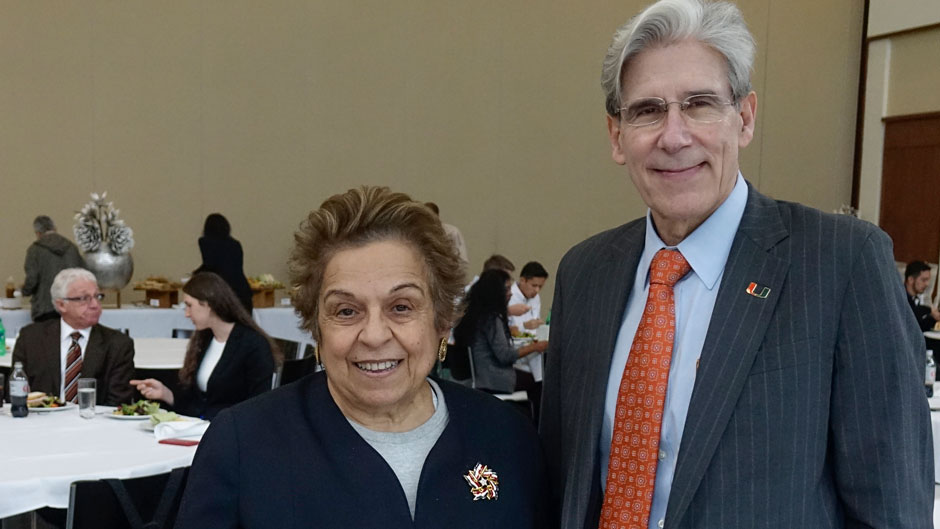The two homemade bombs that were detonated only seconds apart near the finish line of the 2013 Boston Marathon killed three people and injured hundreds more. But what if Dzhokhar and Tamerlan Tsarnaev, the two Chechen brothers who masterminded and carried out the bombing, had been more sophisticated in their attack, aerosolizing a deadly pathogen and spreading the agent over surrounding communities?
Would thousands of victims have streamed into area hospital emergency rooms days later, displaying unusual symptoms? Would Boston’s health care delivery system and local law enforcement units been crippled?
First responders, public health officials, physicians, and politicians could debate the answers for days. But one thing is clear: Whether large-scale biological events are man-made, naturally occurring or deliberate, it takes a combined global and local effort—a so-called “glocal” response—to deal with them, University of Miami President Julio Frenk said Wednesday.
“No individual government can, by itself, guarantee a secure domestic environment nor generate an effective response to most global threats,” Frenk said at a daylong forum hosted by the Blue Ribbon Study Panel on Biodefense, a bipartisan group of former high-ranking government officials and academic experts, including former UM President and U.S. Health and Human Services Secretary Donna Shalala, that analyzes the United States’ defense capabilities against biological threats.
Wednesday’s discussions, moderated by Shalala and held in UM’s Newman Alumni Center, addressed the ability of state, local, tribal, and territorial governments to respond to biological disasters.
“In order to address the health challenges of an interdependent world, we require global cooperation as a condition for effective local response,” Frenk said.
A former secretary of health of Mexico, he said the SARS epidemic, the 2001 anthrax attacks, the avian flu outbreak of 2005, the H1N1 pandemic, and, more recently, the Ebola outbreaks and Zika virus epidemic have helped raise awareness about the critical need to improve health security and develop solid responses to large-scale biological events.
“The first stages of response typically take place locally as do many of the elements of preparedness,” he explained. “But all the actions that can stop an event from actually reaching a local community happen through global cooperation. Rather than this dichotomy between the local and the global, we should think in terms of the ‘glocal.’ ”
To drive home his message, Frenk noted a multilateral health collaboration in which he was involved during his stint as Mexico’s secretary of health. Following the 9/11 attacks, fears that the U.S.-Mexico border would become a pathway for extremists to carry out bio-terrorist attacks led to the establishment in 2002 of a Smart Border plan to promote trade between the two countries and reconcile post-September 11 security issues. In addition, a 2004 revision of the North American Free Trade Agreement added measures related to sanitary and health security, he pointed out.
Frenk also noted the 2001 launch of the Global Health Security Initiative, an international partnership among countries to strengthen global health preparedness and response to biological, chemical, radio-nuclear terrorism, and pandemic influenza threats.
Among the other examples of global cooperation he mentioned: Improved communication between the U.S. Centers for Disease Control and Prevention and Mexico’s National Center for Epidemiological Surveillance and Disease Control that helped strengthen Mexico’s network of 32 public health labs; and U.S., Mexican, and Canadian health officials working together to rapidly identify the H1N1 virus or swine flu—the first cases of which were detected in Mexico in 2009—and implement public health measures to control it.
From “Hospital Preparedness and Response” to “Public Health Response and Population Management,” the forum, held a century since the 1918 flu pandemic that killed an estimated 20 million to 50 million people, addressed a range of topics, with state officials, private sector experts, and other authorities weighing in on the issues.
Noting that Orlando and Las Vegas medical emergency facilities were able to respond effectively to mass-casualty shootings because of their ability to consistently refine their mechanisms of care for such patients, David Zambrana, the senior vice president and chief executive officer of Jackson Memorial Hospital who was formerly CEO of University of Miami Hospital, said hospitals must “develop mechanisms to deal with the uncertainty that a biological threat would pose.”
In its 2015 report, A National Blueprint for Biodefense: Leadership and Major Reform Needed to Optimize Efforts, the Blue Ribbon Study Panel on Biodefense says the United States is “underprepared” for and “dangerously vulnerable” to a biological event, and that “the lack of strong centralized leadership at the highest level of government” is the root cause of that vulnerability.
“These sorts of events are not beyond our imagination,” Shalala wrote in a Miami Herald op-ed piece published two days before the forum. “Books, movies and television constantly illustrate the threat, our vulnerabilities, and the enormous consequences we will have to deal with. The press has made us aware of the increasing abilities on the part of our enemies to produce biological weapons designed to kill millions. We need to take up these scenarios and plan accordingly.”

